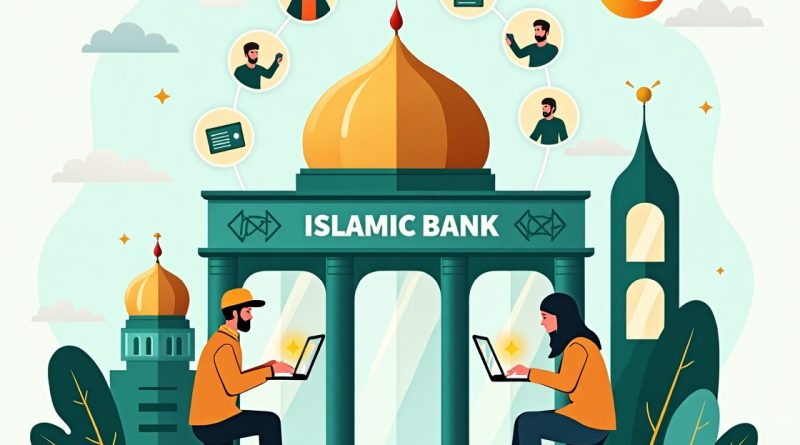Optimizing Islamic Banking Marketing in the Digital Era
By Dr. Abdul Wadud Nafis, LC., MEI
Amid the rapid wave of digital transformation and intense competition in the banking industry, Islamic banking faces both major challenges and opportunities. Despite its noble mission—to offer fair, interest-free financial solutions grounded in Islamic values—its presence has not yet been fully optimized in winning the hearts of the wider public. Frequently, Islamic banks are seen merely as an “alternative” to conventional systems, rather than as the primary choice.
In fact, the potential of the Islamic financial market in Indonesia is enormous. As the country with the largest Muslim population in the world, the demand for sharia-compliant financial products and services continues to grow. However, this potential remains underutilized, partly due to marketing approaches that lack adaptability and fail to connect with the grassroots.
Marketing in Islamic banking is not merely about selling products, but about conveying messages and values. It’s not just about margins and contracts (akad), but about trust, sharia compliance, and blessings. Therefore, a more strategic, innovative, and spiritually relevant marketing approach is needed—one that aligns with the current social realities of the Muslim community.
This study explores strategies for optimizing Islamic banking marketing that are not only competitive in business but also value-driven—positioning Islamic banks as preferred financial institutions that offer both spiritual peace and economic welfare.
Below are the strategies for optimizing Islamic banking marketing, presented in numbered points with accompanying narratives:
1. Value-Based Segmentation and Targeting
Islamic banks must target markets accurately—not just based on demographics like age or location, but based on Islamic values and lifestyles. The main target is not just Muslims in general, but those consciously seeking halal and ethical financial transactions.
Example: Muslim millennials active in hijrah communities, entrepreneurial pesantren students (santri), or halal MSME players.
By understanding psychographic profiles like these, marketing approaches become more effective and foster long-term loyalty.
2. Sharia Financial Education and Literacy
A major challenge for Islamic banks is the public’s low understanding of Islamic financial principles. Many still equate Islamic banks with conventional ones due to similar appearances and procedures.
Solution: Banks should actively conduct public education—seminars, educational social media, trainings in pesantren, and financial literacy programs on campuses.
This educational effort is crucial for developing a conscious and loyal Islamic finance market in the long run.
3. Branding Aligned with Islamic Values
A strong, Islamic-oriented brand builds greater trust among customers. Islamic banks must present themselves not just as providers of halal products, but as institutions that are tayyib (wholesome) in service and operations.
Key narratives like “riba-free”, “transparent”, “blessed”, and “fair” must be emphasized across all promotional channels.
Authentic branding—not just symbolic—will distinguish Islamic banks from other financial institutions.
4. Strengthening Digital Marketing and Technology
In the digital era, marketing must involve online platforms. Islamic banks need to be active on social media, develop user-friendly mobile apps, and use data analytics to personalize services.
Examples: Educational content on Instagram and TikTok, a digital zakat calculator in the app, and AI-powered chatbots for product consultation.
Digitalization allows Islamic banks to reach wider audiences, particularly younger generations.
5. Collaborating with Islamic Communities and Institutions
Islamic banks cannot work in isolation. They must form strategic partnerships with Islamic organizations, pesantren, mosques, zakat institutions, and Islamic cooperatives to expand their outreach and influence.
Programs like “Islamic Banks in Pesantren”, “Productive Waqf Savings”, or “Mosque Financing” are highly effective.
Such collaborations strengthen religious legitimacy and bring Islamic banks closer to the grassroots.
6. Product Innovation Based on Community Needs
Products offered by Islamic banks must be relevant, innovative, and based on valid sharia contracts. Avoid merely imitating conventional products with different terminology.
Innovative examples: Financing cards for Qurban, Qardhul Hasan loans for education, Musyarakah crowdfunding for santri businesses.
With innovation, Islamic banks not only meet financial needs but also provide holistic Islamic life solutions.
7. Islamic and Friendly Services
Excellent service is the most effective form of marketing. In Islamic banking, service should embody Islamic values: honesty, speed, transparency, and ethics.
Bank officers must be trained in Islamic commercial jurisprudence (fiqh muamalah) and Islamic service ethics—not just technical SOPs.
Positive customer experiences will generate strong word-of-mouth promotion.
Conclusion
Optimizing Islamic banking marketing must address three key aspects: spiritual awareness, educational approach, and technological innovation. By integrating Islamic values, digital strategies, and professional services, Islamic banks can become the economic backbone of the ummah—not only competing but also inspiring.
References
1. Antonio, M. Syafi’i. (2001). Bank Syariah: Dari Teori ke Praktik. Jakarta: Gema Insani Press.
2. Ascarya. (2007). Akad dan Produk Bank Syariah. Jakarta: Rajawali Pers.
3. Dusuki, Asyraf Wajdi. (2008). “Understanding the Objectives of Islamic Banking: A Survey of Stakeholders’ Perspectives”. International Journal of Islamic and Middle Eastern Finance and Management, Vol. 1 No. 2, pp. 132–148.
4. Karim, Adiwarman A. (2013). Bank Islam: Analisis Fiqih dan Keuangan. Jakarta: RajaGrafindo Persada.
5. Financial Services Authority (OJK). (2020). Roadmap for the Development of Islamic Banking in Indonesia 2020–2025. Jakarta: OJK.
6. Rahman, Abdul. (2016). “Strategi Pemasaran Bank Syariah di Era Digital”. Jurnal Ekonomi dan Bisnis Islam, Vol. 5, No. 1, pp. 45–55.
7. Kotler, Philip & Keller, Kevin Lane. (2016). Marketing Management (15th ed.). Pearson Education Limited.
8. Yusuf al-Qaradawi. (2000). The Role of Islamic Values and Ethics in Islamic Economics. Jakarta: GIP.
9. Republika. (2022). “Literasi Keuangan Syariah di Indonesia Masih Rendah”. Retrieved from: https://www.republika.co.id
10. Bank Indonesia. (2019). Report on the Development of Islamic Finance in Indonesia. Jakarta: Bank Indonesia.


